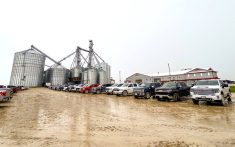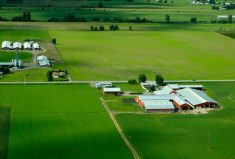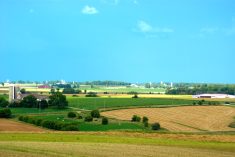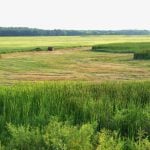Ontario’s farmland values increased exponentially in the last year across all regions, according to the 2021 Farm Credit Canada (FCC) Farmland Values report.
Ontario reported the sharpest increase at 22.2 per cent, quadruple what it was in 2020, followed by British Columbia at 18.1 per cent, said the FCC report.
Why it matters: Rising farmland values make it more difficult for new entrants to become farmers.
Read Also

Canada seventh-most influential country on agri-food
Report from Dalhousie University and MNP shows Canada ranks seventh among G20 countries on agri-food influence.
Between 2012 and 2019, the national farmland value trend indicated a slowdown, but in 2020 prices bumped from 5.2 to 5.4 per cent and jumped by 8.3 per cent in 2021.
“The bottom line is we have a little bit of an acceleration,” said Jean-Philippe Gervais, FCC chief economist. “I’m not surprised that farmland values continue to increase; I’m a bit surprised by the magnitude of the increase, quite frankly.”
Several factors influence farmland values, and while those vary from province to province, the interest rate, favourable commodity prices, and tight supply have supported demand, Gervais said.
“(Those factors) seem to have offset some the many challenges that could have been expected to restrain the demand for farmland and the price producers are willing to pay for land,” he said. “It’s a testament to the resilience and business confidence of farm operators who are largely driving this strong Canadian farmland market.”
The year saw a lot of volatility with pandemic exacerbated labour shortages, supply chain disruptions, farm input inflation, incremental interest rate increases and geopolitical tensions.
Despite projected increases for grain and pulse receipts fueled by strong demand and tight inventories, Gervais warned producers must have solid financial and market risk management plans when considering land investments.
“Land right now is at the highest level relative to income. It is one thing to say that land is expensive, but I always like to point out – against what?” he said. “When we think of agriculture, the point of comparison is with regards to farm income.”
Considering cash receipts for grains and oilseeds were relatively flat or declined slightly in 2021 and the robust valuation of land against farming incomes, Gervais was intrigued that land value increases were consistent across Ontario.
Central West, Eastern and Northern regions saw 18.3 per cent, 12 per cent, and 5. 8 per cent increases respectively, while remaining areas saw farmland increases of between 22.8 and 28.4 per cent.
“The vast majority of buyers would be farm operations, with farming being the main occupation,” said Gervais. “Having said that, the presence of potential buyers does have an impact in the marketplace as well.”
In Ontario, non-traditional buyers, like hobby or part-time farmers, impact land values, particularly those close to urban areas. The diversity of the buyer’s pool influences what farmers are willing to bid, especially when land is close to where they farm or they are looking to expand.
The Ontario Federation of Agriculture (OFA) Homegrown campaign lobbies the government to help keep farmland in production and not have it destined for development. While they don’t want a significant decline in farmland values, they’d welcome moderation in the prices relative to income.
“That’s a huge concern for us, now and in the future,” said Ben Lefort, OFA senior policy analyst. “It’ll likely become an increasing concern over the next number of years.”
Lefort said the biggest issue is land availability.
“There’s not much inventory on the market these days, especially in southwestern Ontario,” he said. “It doesn’t last long, so it’s very hard for farmers to get a foot in the door, so to speak.”
Larger established operations quickly make offers on any land available, and the pandemic impacted the market.
A sudden spike in population and increased development in an area puts upward pressure on all land prices, and that’s reflected in farmland value numbers across Ontario, particularly the GTA, with increased urban expansion.
“We don’t want speculation and non-agricultural factors continuing to drive prices up,” he said.
In areas with low rent-to-price ratios, the concern is doubled.
“York Region is a prime example. The price-to-rent ratio is 0.3 per cent,” he said. “At $40,000 an acre to buy and $100 an acre to rent, that’s signalling some of the farmland being purchased has a lot of non-farm value baked in. That makes it more difficult for farmers to buy the land.”
The last agricultural census showed the small 80- to 100-acre farms consolidating and feeling the land squeeze while major operations and niche-market small farms did well.
“We have a new census coming out this year, and I’m looking forward to the updated data,” Lefort said. “Hopefully, that will have a clearer picture of how it’s been going over the last five years.”
Lefort said while they don’t expect the 2021 number to be maintained, more farmers would be priced out if continued over the next few years.
“We wouldn’t expect that kind of price increase to continue, especially if mortgages have been used to purchase a property,” he said. “If rates go up and mortgages go up, we certainly want to keep an eye on the debt financing levels for farms in Ontario.”
Lefort said a report released by the Ontario Ministry of Agriculture, Food and Rural Affairs (OMAFRA) last month indicated that even with higher prices, the low-interest rates and farming income had supported the debt servicing costs decently over the last while.
“For that to continue, we need to see a levelling of prices and maintaining strong farm income,” he said, adding, although the price of land has increased significantly, the price-to-rent ratio declined.
“For new or beginning farmers, the only viable way (to enter the sector) may be renting, given the significant price of farmland
in (farming-heavy) areas,” said Lefort.
Farm operators should look at several years of farmland value data to understand regional and provincial trends because the market is dynamic, said Gervais, particularly before all 2021 transactions are finalized.
For example, in the last three years, Nova Scotia went from a 4.9 per cent decline in farmland values to a 12.2 per cent increase, a strong indicator of an exodus of producers from high-priced provinces, like Ontario, creating a maritime market influx.
“To get this two-year, three-year perspective gives you a bit of a better idea,” he said, especially at the regional level where growth often evens out over time.
Gervais said that while Ontario is at the top of the valuation cycle regarding the value of the crops grown on the land, it is also in a high commodity price cycle that will subside.
“To have those expectations, those different scenarios in mind when buying land is a good strategy,” he said.
Three wildcards could slow demand for farmland; the rising input prices, interest rates, and 2022 yields are unknown entities.
“Those three things have the potential to shift the demand,” Gervais said.
If input costs continue to rise as everyone fears, or they start to decline, that could slow demand or create investment opportunities.
In anticipation of the Bank of Canada raising rates to slow inflation, many ag operations began transitioning their loan portfolios towards long-term rates and fixed rates when the five-year fixed rate started to climb in April 2021.
With the Russian war on Ukraine, there is enhanced volatility and more questions about what the banks will do.
“We’re pretty much set in terms of the forecast for four to five more increases,” said Gervais. “But I think it’s a wait-and-see what comes, to learn what the extent of the war will look like, the timeline and so forth, to understand what will happen beyond 2022.”















